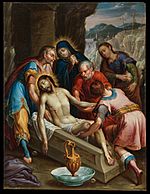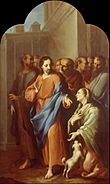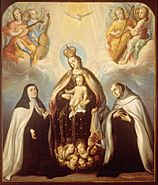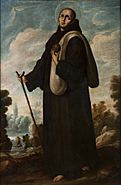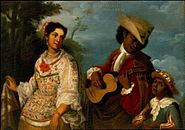Juan Rodríguez Juárez facts for kids
Juan Rodríguez Juárez (born 1675 in Mexico City, died 1728) was a talented artist who lived in New Spain, which is now Mexico. He came from a very famous family of painters. His brother, Nicolás Rodríguez Juárez, was also a well-known artist. Their father, Antonio Rodríguez, and even his grandfather, José Juárez, and great-great-grandfather, Luis Juárez, were all important painters during the Baroque period.
Like many artists in New Spain during his time, Juan Rodríguez Juárez mostly painted religious scenes. He also became known for painting portraits of important people. These included high-ranking officials like Viceroy Linares and other wealthy families. His portraits often followed European styles, showing symbols of power and titles within the painting, sometimes on curtains or other parts of the artwork. He even painted an amazing self-portrait, which showed how artists were becoming more important in the colony during the 1700s.
What are Casta Paintings?
Juan Rodríguez Juárez is also famous for creating a special type of artwork called "casta paintings" around 1715. These paintings showed the different groups of people living in New Spain and how they mixed together. They were like a visual record of the many different families and communities. These paintings are now kept in a private collection in England.
Each painting showed a different family combination. For example:
- A Spanish person and an Indigenous person would have a child called a Mestizo.
- A Spanish person and a Mestiza (a female Mestizo) would have a child called a Castizo.
- A Castizo and a Spanish woman would have a child considered Spanish.
Other paintings showed different mixtures, like:
- A Spanish person and an African woman (Negra) would have a child called a Mulato.
- A Spanish person and a Mulata (a female Mulato) would have a child called a Morisca.
- A Spanish person and a Morisca would have a child called an Albino.
Some paintings showed even more complex mixtures, like:
- A Mulato and a Mestiza could have a child called a Torna atrás (meaning "throw back").
- An African man (Negro) and an Indigenous woman (India) could have a child called a Lobo (meaning "wolf").
- An Indigenous person (Indio) and a Loba (a female Lobo) could have a child with "crinkly hair" called a tente en el air (meaning "hold yourself in midair").
- A Lobo and an India could have a child called a Torna atrás.
- A Mestizo and an India could have a child called a Coyote.
The collection also included paintings of Mexican Indigenous people, Otomí Indigenous people traveling to a fair, and "Barbarian Indians" (Indios Bárbaros). These paintings help us understand how people in New Spain thought about different groups and families at that time.
Gallery
-
Portrait of Viceroy Fernando de Alencastre Noroña y Silva, duque de Linares y marqués de Valdefuentes, around 1717
See also
 In Spanish: Juan Rodríguez Juárez para niños
In Spanish: Juan Rodríguez Juárez para niños
- Mexican art



